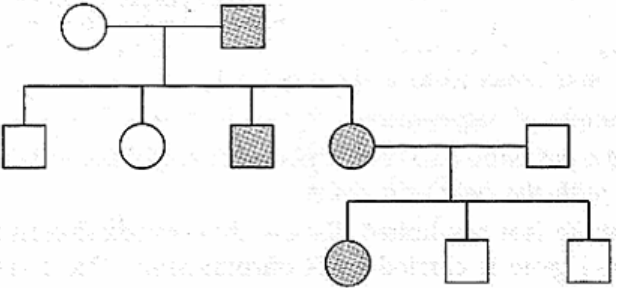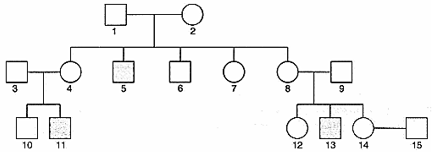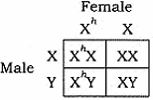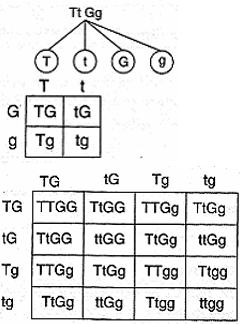Class 12 Biology Principles of Inheritance and Variation Extra Questions. myCBSEguide has just released Chapter Wise Question Answers for class 12 Biology. There chapter wise Test papers with complete solutions are available for download in myCBSEguide website and mobile app. These Extra Questions with solution are prepared by our team of expert teachers who are teaching grade in CBSE schools for years. There are around 4-5 set of solved Biology Extra questions from each and every chapter. The students will not miss any concept in these Chapter wise question that are specially designed to tackle Board Exam. We have taken care of every single concept given in CBSE Class 12 Biology syllabus and questions are framed as per the latest marking scheme and blue print issued by CBSE for Class 12.
CBSE Class 12 Biology Ch – 5 Test Papers
Important Questions for Class 12 Biology Chapter 5
Ch-5 Principles of Inheritance and Variation
- F2 generation is obtained by
- Crossing of F1 and F2
- Crossing of F3 and F4
- Selfing of F2
- Selfing of F1
- Genes are
-
Segment of chromosome
-
Segments of mitochondria
-
Segment of nucleus
-
Segment of DNA
-
-
Map distance of genes on chromosome is calculated by
-
Non-cross over percentage
-
Recombination frequency of each gene locu
-
Cross over percentage
-
Number of mutant genes
-
- Dihybrid cross proves the law of
-
Purity of gametes
-
Law of independent assortment
-
Segregation
-
Dominance
-
-
Each gametes carry
-
Only recessive allele
-
Glucose
-
Only one of the alleles
-
Only dominant allele
-
- The phenotypic and genotypic ratios in F2F2 generation are same in a certain kind of inheritance. Name and organism in which it occurs and mention the kind of inheritance involved.
-
A diploid organism is heterozygous for 4 loci, how many types of gametes can be produced?
-
A garden pea plant produced round green seeds. Another of the same species produced wrinkled yellow seeds. Identify the dominant traits.
-
Kavita’s parents suffer from high blood pressure and are obess. Kavita is also worried about her health. Do you think kavita can inherit these characteristic from parent. Suggest two measures kavita can adopt to avoid high blood pressure and obesity.
-
How is sex determined in human beings?
-
Briefly mention the contribution of T.H. Morgan in genetics.
-
How is a child affected if it has grown from the zygote formed by an XX-egg fertilized by a Y-carrying sperm? What do you call this abnormality?
-
Study the given pedigree chart and answer the questions that follow:

- Is the trait recessive or dominant?
- Is the trait sex-linked or autosomal?
- Give the genotypes of the parents shown in generation I and their II child is shown in generation II and the first grandchild shown in generation III.
-
Haemophilia is a sex-linked recessive disorder of humans. The pedigree chart given below shows the inheritance of haemophilia in one family. Study the pattern of inheritance and answer the questions given.

- Give all the possible genotype of the members 4, 5 and 6 in the pedigree chart.
- A blood test shows that the individual 14 is a carrier of haemophilia. The member numbered 15 has recently married the member numbered 14. What is the probability that their first child will be a haemophilic male?
-
A homozygous tall pea plant with green seeds is crossed with a dwarf pea plant with yellow seeds.
- What would be the phenotype and genotype of F1 generation?
- Work out the phenotypic ratio of F2 generation with the help of a Punnett square.
Ch-5 Principles of Inheritance and Variation
Answer
-
- Selfing of F1, Explanation: In monohybrid and dihybrid cross F2 generation is obtained by selfing of Fi hybrids as male and female.
-
- Segment of DNA, Explanation: Genes are segment of DNA present on chromosome. Large numbers of genes are located on single chromosome. A gene or genes determines the traits of the individual.
-
- Cross over percentage, Explanation: Map distance is tools to find the distance between two genes on a chromosome. The genes closer to each other shows less number of crossing over percentage.
-
- Law of independent assortment, Explanation: In dihybrid cross, two new kinds of plants with new trait are formed. This is possible only when all traits assort independently and recombine to form new combination.
-
- Only one of the alleles, Explanation: Each gametes carry single set of chromosomes. During gamete formation each pair of alleles separate from each other as reduction division occurs.
- It occurs in snapdragon / antirrhinum sp. (dog flower). The inheritance involved is incomplete dominance.
- 2424 (16 gametes can be produced) types
- Round and yellow.
- 1) No, these are life style related diseases
2) Any two measures- changing in food habits, exercises, leading active life, meditation.
Values
• Awareness about health.
• Understanding. - A baby’s genetic sex is determined at the time of conception. When the baby is conceived, a chromosome from the sperm cell, either X or Y, fuses with the X chromosome in the egg cell, determining whether the baby will be genetically female (XX) or male (XY).
- Thomas Hunt Morgan put forth chromosome theory of linkage from this work on fruit fly (Drosophila melanogaster). He established the principle of linkage, discovered sex linkage and technique of chromosomal mapping. He wrote a book ‘Theory of Gene’ and was awarded Nobel Prize in 1933.
- The union of an abnormal XX egg and a normal Y sperm results in trisomy of sex (X) chromosome. This is a type of sex chromosomal abnormality where the individual has 47 chromosomes (44 + XXY) and the abnormality is called Klenifelter’s syndrome.
-
- Dominant
- Autosomal
- Parents Mother -aa
Father – Aa
Third child – Aa
First grandchild – Aa
-
- Members Genotypes
4XhX
4XhX
6 XY 
Male Female Xh X X XhX XX Y XhY XY
The probability of a first child being a haemophilic male is 25%.
- Members Genotypes
-
- Phenotypically all the plants of F1 generation would be tall with green seeds. The genotype of all the would-be Tt Gg. i.e. hybrid tall plant with green seeds.
- For F2 generation


T t G TG tg g Tg tg TG tg Tg tg Tg TTGG TtGG TTGg TtGg tg TtGG ttGG TtGg ttGg Tg TTGg TtGg TTgg Ttgg tg ttGg Ttgg Ttgg ttgg
Tall plants with green seeds – 9
Dwarf plants with green seeds – 3
Tall plants with yellow seeds – 3
Dwarf plant with yellow seeds – 1
Phenotypic ratio – 9 : 3 : 3 : 1
Class 12 Biology Chapter Wise Test Paper
- Reproduction in Organisms
- Sexual Reproduction in Flowering Plants
- Human Reproduction
- Reproductive Health
- Principles of Inheritance and Variation
- Molecular Basis of Inheritance
- Evolution
- Human Health and Disease
- Strategies for Enhancement in Food Production
- Microbes in Human Welfare
- Biotechnology Principles and Processes
- Biotechnology and its Applications
- Organisms and Populations
- Ecosystem
- Biodiversity and Conservation
- Environmental Issues

Test Generator
Create question paper PDF and online tests with your own name & logo in minutes.
Create Now
Learn8 App
Practice unlimited questions for Entrance tests & government job exams at ₹99 only
Install Now